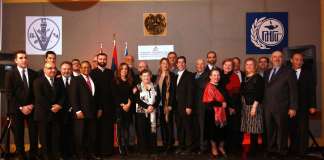On the occasion of the 25th anniversary of Independence of the Republic of Armenia, the Armenian Diocese of Canada, with blessings of His Grace Bishop Abgar Hovakimian, Primate, organized a 14-day pilgrimage. 30 pilgrims from Montreal, Toronto, Vancouver, Laval, and beyond, are celebrating Armenia’s Independence in Armenia.
On September 18, 2016, pilgrims visited Mother See of Holy Etchmiadzin, the spiritual center of all Armenians where they received blessings from His Holiness Karekin II, Supreme Patriarch and Catholicos of All Armenians. The same day, they visited The Alex and Marie Manoogian Treasury House Museum of the Mother See, the churches of St. Hripsime and St. Gayane, and the archeological site of Zvartnots. Cathedral and Churches of Etchmiadzin and the Archaeological Site of Zvartnots have been inscribed in the UNESCO World Heritage List.
On September 19, pilgrims met Mrs. Hranush Hakobyan, Minister of Diaspora of the Republic of Armenia.
After the meeting, they travelled to the province of Kotayk where they visited the Temple of Garni – a classical Hellenistic temple, which is the best-known structure and symbol of pre-Christian Armenia.
From Garni pilgrims travelled to the monastery of Geghard, which contains a number of churches and tombs, most of them cut into the rock, which illustrate the very peak of Armenian medieval architecture. The complex of medieval buildings is set into a landscape of great natural beauty, surrounded by towering cliffs at the entrance to the Azat Valley. The monastery was renowned for the relics housed there. The most celebrated of these was the spear, which had wounded Christ on the Cross and was brought there by the Apostle Thaddeus, from which comes its present name, Geghardavank (the Monastery of the Spear). The spear was kept in the Monastery for 500 years. The monastery of Geghard has been inscribed in the UNESCO World Heritage List. On the evening pilgrims had an opportunity to visit the Yerevan Opera House and to enjoy a concert performed by the “Barekamutyun” Armenian State Dance Ensemble.
On Tuesday, September 20, pilgrims visited Erebuni Historical and Archeological Museum-Reserve.The Erebuni settlement was constructed in 782 BC by one of the greatest kings of Urartu, Argishti the First. From there pilgrims traveled to the Ararat Cognac Factory founded in 1887 where they had a degustation of various kinds of famous Armenian brandy.
The same day, pilgrims visited the Tsitsernakaberd Memorial Complex – Genocide Museum and laid flowers at the eternal flame in memory of the victims of the Genocide.
On September the 21st pilgrims celebrated the 25th anniversary of Independence of the Republic of Armenia.
On September the 22nd pilgrims guided by His Grace Bishop Abgar Hovakimyan, Primate, met His Holiness Karekin II, Supreme Patriarch and Catholicos of All Armenians at the spiritual center of all Armenians – Mother See of Holy Etchmiadzin. They received Patriarchal blessings.
Afterwards, pilgrims visited the Museum of the Mother Cathedral.
The same day, pilgrims visited St. Mersob Cathedral in Oshakan, where the Saint creator of the Armenian alphabet Mesrob Mashtots is buried.
Afterwards, they traveled towards the slopes of Mount Aragats to visit Amberd – a 7th century fortress and the adjacent Vahramashen church built in 1026 by Prince Vahram Pahlavuni.September the 23rd pilgrims passed in Yerevan where they visited the History Museum and National Gallery of Armenia, architectural complex Caskad and the Matenadaran – Mesrop Mashtots Institute of Ancient Manuscripts.
The next day, on September the 24th pilgrims traveled to the Province of Vayots Dzor. On their way towards Goris they visited Khor Virap monastery located in the Ararat Plain. Khor Virap means “deep pit”. St. Gregory the Illuminator was imprisoned here for 14 years by King Tiridates III of Armenia. From there pilgrims traveled to Areni village, which is widely known for its wine production, where there were joined by His Eminence Archbishop Abraham Mkrtchyan, Primate of the Diocese of Vayots Dzor. Afterwards pilgrims visited Noravank – a 13th-century monastery, located in a narrow gorge made by the Amaghu River. That night pilgrims passed in Goris.
On September 25, pilgrims reached the Republic of Artsakh (Nagorno-Karabakh), where they visited Shushi and Ghazanchetsots Cathedral.
From there pilgrims visited “We Are Our Mountains” monument and the Pantheon of Brotherhood. Afterwards, pilgrims visited a boarding school and presented gifts to the children. That night pilgrims passed in Stepanakert, the Capital of the Republic of Artsakh.
On September 26, a meeting with Mr. Ashot Ghulyan, Speaker of the Parliament of the Republic of Artsakh (Nagorno-Karabakh) was held at the National Assembly of Artsakh.
From there pilgrims traveled to Gandzasar monastery – a 10th to 13th century Armenian monastery situated in the Mardakert district of the Republic of Artsakh. In Armenian “Gandzasar” means treasure mountain and the monastery has gained its name because it holds relics of St. John the Baptist and his father St Zechariah. The same day, His Grace Bishop Abgar Hovakimyan, Primate, met His Eminence Archbishop Pargev Martirosyan, Parimate of the Diocese of Artsakh, and visited the construction site of a new church.
On September the 27th pilgrims visited Khndzoresk – a village in the province of Syunik. The village is located on the steep slopes of Khor Dzor (Deep Gorge), from which, according to tradition, it got its name. From there the traveled to Zorats Karer, also called Karahunj – a prehistoric archaeological site near the town of Sisian in the Syunik Province of Armenia. The phrase Zorats Karer is literally translated from Armenian as Army Stones. It is also often referred to as the ‘Armenian Stonehenge.’
The next stop was the Tatev monastery – a 9th century Armenian Apostolic monastery located on a large basalt plateau near the Tatev village. The monastic ensemble stands on the edge of a deep gorge of the Vorotan River. In the 14th and 15th centuries the monastery hosted one of the most important Armenian medieval universities, the University of Tatev, which contributed to the advancement of science, religion and philosophy, reproduction of books and development of miniature painting. Scholars of the Tatev University contributed to the preservation of Armenian culture and creed during one of its most turbulent periods in its history. From Tatev pilgrims traveled to Sevan and passed that night in Sevan.
On September 28, pilgrims visited lake Sevan and Sevanavank – a monastic complex located on a peninsula at the northwestern shore of the lake. According to an inscription in one of the churches, the monastery of Sevanavank was founded in 874 by Princess Mariam, the daughter of Ashot I, who became a king a decade later.
From Sevan pilgrims traveled to Dilijan, where they first visited Goshavank, or “Monastery of Gosh” – a 12th century Armenian monastery located in the village of Gosh in the Tavush Province of Armenia. Mkhitar Gosh – author of the first criminal code, took part in the rebuilding of the monastery. At Goshavank, Mkhitar Gosh founded a school. One of its alumni, an Armenian scientist by the name of Kirakos Gandzaketsi wrote The History of Armenia. The architect Mkhitar the Carpenter and his disciple Hovhannes also took an active part in the building of the monastery. The complex was later renamed Goshavank and the village named Gosh in his honor. The impressive monastery also houses one of the world’s finest examples of a Khachkar. From Goshavank pilgrims traveled to Haghartsin – a 13th century monastery located near the town of Dilijan. From Haghartsin pilgrims returned to the capital Yerevan.
September the 29th, the last day of the pilgrimage, pilgrims had a full day of leisure in Yerevan thus concluding their unforgettable trip to the Motherland.














